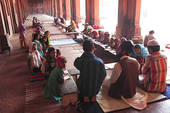 HYDERABAD: “Despite marked improvement in the developmental indices of Muslims, the community lags behind the national average.” This is the observation of the Parliament’s standing committee on Social Justice and Empowerment on the Demands for Grants for the Ministry of Minority Affairs (MoMA) for 2013-14. The committee, in its 37th report tabled in Parliament on May 2, noted that Muslim community is lagging behind in education and job sector in comparison to other minority communities. The large drop-out rates in schools is stated to be the main reason for this. The committee quoted the MoMA’s assertion that due to constant endeavour through various schemes dedicated to the minority community like the Prime Minister’s New 15-Point Programme for the Welfare of Minorities, the situation has improved in the recent years and the all-round effect would be visible once the data of census 2011 pertaining to SRGs becomes available. Literacy rate among Muslims in rural and urban areas for the year 1999-2000 and 2007-08 has registered a marked improvement from 52.1% to 63.5% and from 69.8% to 75.1% respectively. The recruitment of minorities in Central government jobs has increased from 6.93% in 2006-07 to 11.55% in 2010-11. The committee observed that the results for the utilization of funds for the ministry, which constitute only 0.67 percent of the total budget of the Central government for the year 2013-14, are far from adequate as there are still a large number of Muslim inhabited areas in the country where the fruits of progress are yet to reach.
HYDERABAD: “Despite marked improvement in the developmental indices of Muslims, the community lags behind the national average.” This is the observation of the Parliament’s standing committee on Social Justice and Empowerment on the Demands for Grants for the Ministry of Minority Affairs (MoMA) for 2013-14. The committee, in its 37th report tabled in Parliament on May 2, noted that Muslim community is lagging behind in education and job sector in comparison to other minority communities. The large drop-out rates in schools is stated to be the main reason for this. The committee quoted the MoMA’s assertion that due to constant endeavour through various schemes dedicated to the minority community like the Prime Minister’s New 15-Point Programme for the Welfare of Minorities, the situation has improved in the recent years and the all-round effect would be visible once the data of census 2011 pertaining to SRGs becomes available. Literacy rate among Muslims in rural and urban areas for the year 1999-2000 and 2007-08 has registered a marked improvement from 52.1% to 63.5% and from 69.8% to 75.1% respectively. The recruitment of minorities in Central government jobs has increased from 6.93% in 2006-07 to 11.55% in 2010-11. The committee observed that the results for the utilization of funds for the ministry, which constitute only 0.67 percent of the total budget of the Central government for the year 2013-14, are far from adequate as there are still a large number of Muslim inhabited areas in the country where the fruits of progress are yet to reach.The committee found three distinct reasons for ‘surrender’ of funds in respect of central sector schemes and centrally sponsored schemes. These included budgetary cut made by the finance ministry at the revised estimates stage, non-receipt of adequate and viable proposals leading to non-implementation of schemes and delay in completing the process of appraisal and approval of many of the new schemes during 2012-13.
Expressing its dismay, the committee noted that the budgetary cuts at the revised estimate stage were ostensibly due to non- utilization of funds on account of non-receipt of proposals and utilization certificates. In some cases, the schemes could not take off at all for non-appraisal and approval of schemes by the Planning Commission.In this backdrop, the committee recommended that the MoMA should ask all the state governments to send the proposals in the first quarter of the fiscal year itself. Evaluation of proposals and release of funds should be made by the second quarter, and status report should be made available to the committee on the progress made by MoMA every quarter.
(The writer is a member of legislative council and a journalist)
Government of India
Ministry of Minority Affairs
As a follow-up action on the Sachar Committee recommendations, various schemes have been implemented to improve the socioeconomic conditions of minorities. The overall effect of the steps taken by the Government for improving the conditions of minorities would be known once the data of census 2011 becomes available. As per the India Human Development Report of the Planning Commission, literacy rate among Muslims has registered a marked improvement from 52.1% in 1999-2000 to 63.5% in 2007-08 for rural areas and from 69.8% to 75.1% for urban areas. The literacy rate of Muslims as ratio of national average has gone up from 0.93 in 1999-2000 to 0.95 in 2007-08 for rural areas. The figure for urban areas has gone up from 0.87 in 1999-2000 to 0.89 in 2007-08. As per the National Sample Survey Office (NSSO) Report on employment and unemployment situation among major religious groups in India (2009-10), it has been, inter alia, observed that unemployment rate for minority communities have declined in 2009-10 as compared to 2004-05 in both rural and urban areas. Among minorities, the unemployment rate in rural areas was lowest for Muslims. In urban areas unemployment rate was lowest for Christians followed by Muslims.
The status of minorities with regard to education and employment opportunities is evaluated through the Census data and the Reports of National Sample Survey Office (NSSO), Ministry of Statistics and Programme Implementation, which conducts all-India sample surveys in diverse socioeconomic areas, including employment and education.
Educational empowerment, skill development, area development and economic empowerment, which impact the livelihood opportunities for the minorities, have been adequately addressed in the 12th Five Year Plan (FYP). Plan allocation for the Ministry of Minority Affairs has been increased from Rs.7000 crore during 11th FYP to Rs.17,323 crore during the 12th FYP.
This was stated by Shri Ninong Ering, the Minister of State in the Ministry of Minority Affairs in response to a written question in Lok Sabha yesterday.

